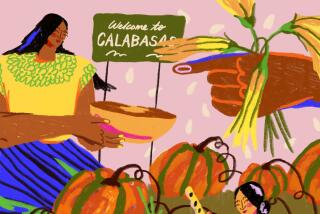Right Time for Winter Squash
- Share via
It happens almost overnight with the end of summer: Suddenly, brightly colored pumpkins and exotic winter squashes appear in the markets. These vegetables are loaded with antioxidants, yet many will end up as centerpieces or carved for Halloween. The flesh of winter’s squashes is much darker than summer’s and thus is more nutritious, containing larger quantities of complex carbohydrates and usually more beta carotene. For example, a 31/2-ounce serving of Hubbard and butternut squashes contains enough beta carotene to supply 100% of the recommended daily allowance of vitamin A.
There are many winter squash varieties from which to choose, but although the flavors and textures vary, it is easy to substitute one squash for another in most recipes (the exception being spaghetti squash, which has a unique flesh).
Acorn squash: This is excellent for baking. Shaped like a large acorn, it is about 6 inches long. Although the exterior coloring may vary, all varieties have a yellow-orange flesh that, despite the color, contains little beta carotene. They are rich in calcium (1 cup of baked squash contains 90 milligrams, which is about 11% of the recommended daily allowance).
Banana squash: Large and cylindrical, these can weigh up to 30 pounds. The skin ranges from pale yellow to ivory, and the orange flesh is finely textured.
Buttercup squash: This decorative squash has a squat shape and a cap opposite the stem end. Its dark-green skin features light-green stripes. The flesh is orange and sweet but a little dry.
Butternut squash: This squash, which can weigh from 2 to 4 pounds, typically resembles an elongated bell with a tan rind. The orange flesh is somewhat sweet. Because the skin is softer than many other winter squashes, it may be easier to cut up and prepare and is high in beta carotene.
Calabaza: A very large squash that is often sold in cut portions, the calabaza is usually bright orange but can also be green, yellow or cream. When cooked, it is sweet and moist.
Delicata: Called the Bohemian squash, it usually weighs 1 to 2 pounds. The shape is oblong and the skin cream-colored and striped in shades of green and orange. Its flesh is yellow and sweet.
Golden nugget: This looks like a small pumpkin and usually has just enough flesh for one serving. Like acorn squash, it is best when baked whole or in halves.
Hubbard squash: These weigh 5 to 15 pounds and are usually found pre-cut. The whole squash is round in the middle and tapered at the neck, with bumpy skin that can vary from dark green to light blue to orange. Hubbards are high in beta carotene.
Pumpkin squash: Most of the pumpkins grown for jack-o’-lanterns are too stringy to eat, but sugar pumpkins, which are smaller and sweeter, are wonderful in pies, soups and other dishes.
Spaghetti squash: When cooked, the flesh forms spaghetti-like strands used as pasta. It is delicious and low in calories, but takes more preparation time than most squashes.
Sweet dumpling: This is a one-serving squash that can be cooked whole. The skin is light in color with dark-green stripes.
Turban squash: This has an orange base and dark-green stripes, with a cap similar to that of the buttercup squash. It looks better than it tastes so is often used for decoration.
*
Dr. Sheldon Margen is a professor of public health at UC Berkeley; Dale A. Ogar is managing editor of the UC Berkeley Wellness Letter. Send questions to Dale Ogar, School of Public Health, UC Berkeley, Berkeley, CA 94720-7360, or e-mail to daogar@uclink4.berkeley.edu. Eating Smart appears on the second and fourth Mondays.
More to Read
Eat your way across L.A.
Get our weekly Tasting Notes newsletter for reviews, news and more.
You may occasionally receive promotional content from the Los Angeles Times.








